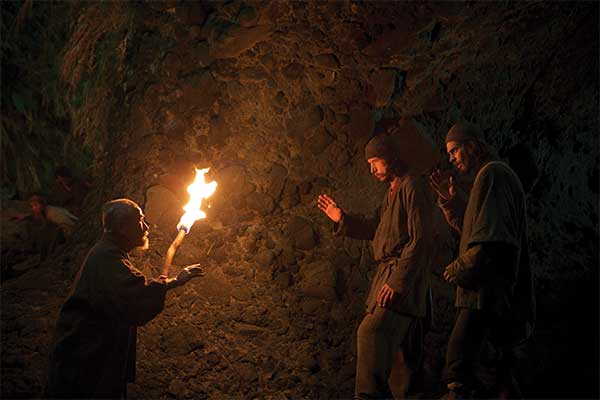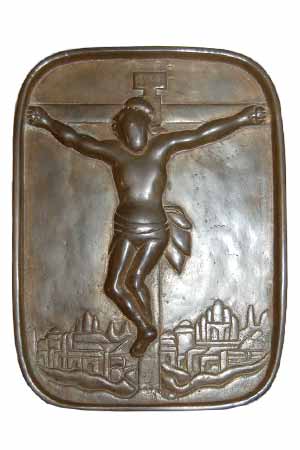Subtotal: $
Checkout-

Editors’ Picks Issue 12
-

Traudl Wallbrecher
-

The Man Who Welcomed Immigrants
-

The Soil of Friendship
-

Thomas Müntzer
-

A Time for Courage
-

“What is Truth?”
-

Readers Respond Issue 12
-

At the March For Life
-

Why the Death Penalty Must Die
-

God’s Cop
-

The Teacher Who Never Spoke
-

Bonhoeffer in China
-

The Comandante and the King
-

Confronted by Dorothy
-

Insights on Courage
-

The Art of Courage
-

Why We Hope
-

Harlem Postcards
-

T. S. Eliot’s “Little Gidding”
-

The Need of Refugees

Silence. Could this possibly be God’s answer to our most desperate prayers? Did God really hide his face as thousands of Christian martyrs were tortured to death?
I’d read Shusaku Endo’s novel Silence twice before watching Martin Scorsese’s recent film adaptation. Any skepticism about Hollywood’s ability to do justice to the story soon evaporated. The film is majestic and deeply disturbing in the same way the book is, with the potential to stir deep questions of doubt, faith, and forgiveness in a far larger audience. This historically grounded tale of religious persecution probes the core of what it means to follow Jesus, even more deeply than the glorious accounts of early Christian and Reformation-era martyrdom on which I was raised.
Jesuit priest Sebastian Rodrigues is ready to give his life for Christ and the church’s missionary endeavor in seventeenth-century Japan, where brutal persecution has driven the faith underground. To escape death and torture, Christians can prove their renunciation of Christ only by stepping on his face. The fumi-e, the bronze relief sculptures used for this purpose, are worn smooth with the trampling of many thousands of feet.
The worn fumi-e graphically illustrates a fact that has held true in every age: for every heroic martyr who holds firm to the end, there are others who apostatize under duress, often repeatedly. The strong – the Japanese peasant Mokichi bound to a cross in the sea, who dies singing hymns after days of water torture in the surf, and missionary priest Garrpe, who throws himself into the sea to rescue his parishioners or die with them – are promised paradise. But what of the weak? Scorsese manages to evoke sympathy for even the despicable character Kichijiro, a stinking, drunken weakling who repeatedly denies his Lord and betrays his fellow Christians, only to return groveling for forgiveness and reacceptance. Had he not been born into a time of persecution, Kichijiro reminds those of us who have not, he could easily have remained a good Christian to the end.

After wading ashore by night, missionary priests Garrpe (Adam Driver) and Rodrigues (Andrew Garfield) are welcomed by Ichizo (Yoshi Oida), a secretly Christian Japanese fisherman who will be crucified as a result, in the film Silence. Photo: Kerry Brown © 2016 Paramount Pictures. All Rights Reserved.
Rodrigues, the last surviving priest in the country, is prepared to suffer, but can he withstand the torment his sadistic inquisitor, Inoue, Lord of Chikugo, has in mind for him? The foreign priest is forced to stand by as the Japanese peasants for whom he came are drowned or hung upside down in pits in his stead. They have already apostatized repeatedly, but will not be spared unless he, Rodrigues, denies Christ. Only after a night listening to the moaning of the Christians in the pits does he finally hear Christ speaking clearly to him, urging him to trample, to lay down his martyr’s crown, his office and good name, his religion, and possibly even his own salvation to save the lives of others. Rodrigues steps on the fumi-e. A cock crows.
Any of us in his place might have done the same. And to be sure, “No one has greater love than this, to lay down one’s life for one’s friends” (John 15:13). Yet the question lingers: Was that really Jesus speaking? Is that what he would have wanted? It’s easy to see the appeal of this Jesus, not only in Japan, a Buddhist culture with a different, more human, conception of the divine, but also in the spiritual-but-not-religious, post-modern West, which prizes ambiguity over certainty, doubt over faith, and the humanity of Jesus over his lordship.
The Jesus we meet in the Gospels is often far less ambiguous: “Whoever denies me before others, I also will deny before my Father in heaven” (Matt. 10:33). So is the apostate still doing Christ’s will, even as he – unlike the original Christ-denier, the apostle Peter – goes on to collaborate with the Japanese authorities in the suppression of the faith and takes up a life of relative comfort compared with the Christian peasants he has abandoned? Will we find out when his betrayer, Kichijiro, returns once again on his knees, begging Rodrigues to hear his confession and grant absolution? The fallen priest would like to refuse, but once more Christ breaks his silence, and Rodrigues pronounces forgiveness.
What are we to make of the God who foreknew Peter’s denial and Judas’s betrayal, the Creator of our own fickle hearts? For Endo and Scorsese show us that we too are Peter and Judas, Rodrigues and Kichijiro, always failing to emulate our Lord no matter how doggedly we stumble toward him.
Japanese-American artist Makoto Fujimura, in his 2016 book Silence and Beauty, describes the effect Silence has had on his journey as an artist and a Christian. He memorably recounts his own first encounter with the worn fumi-e in a Tokyo museum, and the day he stood on Martyrs Hill in Nagasaki, where twenty-six Japanese Christians were crucified in 1597 after being marched 480 miles with their noses and ears cut off. The hill overlooks Ground Zero, where in 1945 the United States obliterated one of the leading centers of Christianity in Japan. In an age of proliferating Ground Zeros, Fujimura suggests, Silence offers “an antidote to the world of trauma, torture, and religious persecution”:
When we identify with less than noble characters like Kichijiro …or failed priests like Father Rodrigues … we are being injected with a vaccine that makes us realize, if we allow ourselves to be honest, that we actually resemble these weak, sometimes comically failed characters. Endo’s books expose our true selves.… But this awareness can liberate us, Endo suggests, toward compassion, an antidote to a fear-filled world.
Silence may not answer the questions it poses; like much true religious art, it opens us up to the mystery of human frailty and God’s justice. All the same, the film remains art, not “what really happened.” Under the influence of its beguiling cinematography, we can easily forget that what it presents is at best a partial truth, perhaps even a false choice.
And so something more needs to be said. Over and against Scorsese’s vision stands the historical record of the faithful martyrs. On February 5, 1597, when the twenty-six Christians arrived at the Nagasaki hill where their crosses awaited them, one of the youngest, twelve or thirteen years old, reportedly said, “Show me my cross.”
For the first two centuries of Christian history, there are many records of martyrs but very few of apostates. (That only changed with the Decian persecution of AD 250, when, threatened with systematic and sadistic torture, thousands of Christians recanted, presenting the early church with a painful dilemma: what forgiveness could be offered remorseful apostates, and how often?) Another parallel can be found in the areas of sixteenth-century Europe where Anabaptism was a capital crime. Of the Anabaptists who were captured and actually faced the death penalty, around half recanted. This is not surprising. What’s remarkable is that the other half of them, eventually numbering several thousand, did not. In many cases they – like Mokichi in Scorsese's film, and like many other Christian martyrs of the era, as recounted in Brad Gregory’s Salvation at Stake – went to their deaths singing.
For me, after watching Silence, one thing is all the more certain: God may have been silent at times – perhaps he sometimes even speaks in silence – but he was surely never absent. Not in seventeenth-century Japan, nor in the Roman Colosseum, nor on Golgotha. Nor is he silent today in Northern Africa and the Middle East, where believers still face the sword and the cross. As Auschwitz survivor Elie Wiesel writes in Night, “Here he is – he is hanging here on this gallows.”
 A seventeenth-century fumi-e. Photograph by Eijer
A seventeenth-century fumi-e. Photograph by Eijer
Already a subscriber? Sign in
Try 3 months of unlimited access. Start your FREE TRIAL today. Cancel anytime.
































Ellen Haroutunian
In regards to Matt. 10, we deny Christ whenever we turn our backs on the poor, the sick, the marginalized, the imprisoned, etc. Christ clearly stood in solidarity with them and identified with their state. (Mat. 25) What the priest did in the story mimicked Christ's kenosis- emptying himself even of being God to join us in our helpless state. He emptied himself of his own religious pride. His act flies in the face of the erroneous belief that we can earn God's love and salvation. It's an expression of religious hubris to believe that Christ cares more about stepping on a symbol than the suffering of his own. Perhaps in this act not only did he show mercy for the others, but gave up any remaining pretense of self righteousness. The book seems to ask the question, will you give up your Christianity, in order to follow Christ?
Erna Albertz, Plough.com
Have you watched Scorsese’s film, Silence? Please share your impressions.